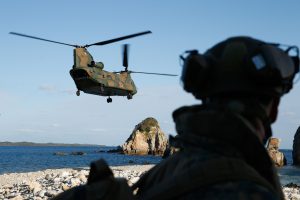A Japanese government panel of experts has proposed that the nation acquire “counterstrike capability” against an armed enemy attack as well as an imminent attack, and called for raising taxes to finance a significant increase in defense spending in order to “fundamentally reinforce defense capabilities within five years.”
The proposal will likely be the basis for updating the nation’s three key security documents next month, marking a big departure from Japan’s postwar status as a lightly-armed economic power with an exclusively defense-oriented policy defined by its pacifist constitution.
The blue-ribbon panel’s chair, former Ambassador to the United States Sasae Kenichiro, visited Prime Minister Kishida Fumio on November 22 to submit its proposal-style report.
The report “is important advice, and we will promote discussions on necessary defense power, budget and fiscal resources, while closely coordinating with the ruling parties,” Kishida said at the meeting with the former diplomat.
Counterstrike Capability
“The balance of power in the Indo-Pacific has changed significantly, and neighboring countries are rapidly increasing their nuclear missile capabilities in terms of both quality and quantity,” the report stated, adding that “possession and enhancement of Japan’s counterattack capability is essential for maintaining and improving deterrence.”
In doing so, the report proposed the nation “equip itself with a sufficient number of missiles as soon as possible, keeping in mind (a time frame of) the next five years, by improving domestically produced stand-off missiles and purchasing foreign-made missiles.”
Japan’s Ministry of Defense (MoD) is currently developing an extended-range version of the domestically developed Type 12 surface-to-ship missile in a bid to bolster its defense, especially against China’s increasing military activities inside and outside the East China Sea, where the Senkaku Islands are located. The islands, also known as the Diaoyu Islands, are controlled by Japan but also claimed by China.
In addition, Japan is considering buying U.S.-developed Tomahawk cruise missiles, which have a range of up to 1,600 kilometers and can fly at a low altitude while continually adjusting trajectory to strike targets with great accuracy.
Tokyo plans to revise three key security documents – the National Security Strategy (NSS), the National Defense Program Guidelines, and the Medium-Term Defense Program – by the end of the year. This is the second time the government will update the NSS. The first NSS was formulated in 2013 during the second Abe Shinzo administration.
The biggest focus of these three documents will be the nation’s possession of counterstrike capabilities, Kawano Katsutoshi, a former chief of staff and joint staff in Japan’s Self Defense Forces (JSDF), said in a speech in Tokyo on November 20.
Kawano pointed out there is a difference of opinion between the ruling Liberal Democratic Party (LDP) and its junior coalition partner, Komeito, a historically pacifist party, over how far the JSDF can protect the nation against a war of aggression.
For example, the LDP says the counterattack capability should include the capability to attack an enemy’s command and control systems as well as military bases, while Komeito is reluctant to do so and takes the stance of defending the country “within the minimum necessary range.”
“Komeito insists our nation should protect our country with a minimum defense capability as well as the minimum necessary measures, even if we obtain the counterstrike capability, but why should we stick to the minimum necessary to respond to a war of aggression?” Kawano asked the audience. “Shouldn’t the JSDF make a full-commitment at such a crucial time?”
Because of Komeito, “I don’t think this will happen this time, but I think it’s a step forward just by including the ability to counterattack,” he said.
Broad-based Tax Burden
The second attention point of the report is that the panel proposed the government make clear that a broad-based tax burden is necessary. The panel did not name specific taxes but it is widely believed it had corporate and income taxes in mind.
The Japanese defense ministry estimates Tokyo will need to spend 48 trillion yen ($340 billion) on defense over the next five years if it wants to achieve its security goals. The figure is about 1.7 times the five-year defense spending from fiscal 2019, which stood at 27.47 trillion yen. The new five-year plan would start from fiscal 2023.
Dual Use
The third focal point of the report is about the significance of dual-use technologies that are changing the character of warfare much faster than expected in Ukraine and elsewhere.
“In order to strengthen the comprehensive defense system, it is essential to cooperate not only with researchers in the field of security, but also with a wide range of cutting-edge researchers in academia and the private sector,” the report said.
“For cutting-edge science and technology such as space, cyber, AI, quantum computing, and semiconductors, it is essential not only to create a framework for research and development, but also to involve cutting-edge researchers,” it added.
This will also mark a major turning point for Tokyo in departing from its postwar pacifism. In Japan, almost all scientists have vowed to avoid military research in repentance for cooperating with the military in the years leading up to World War II. So, the government’s push to fund research into dual-use technologies could spark an ethics debate among some scientists, although the importance of national security is also being recognized amid an increasingly severe security environment surrounding Japan.

































